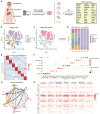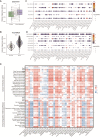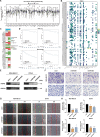Single-cell histone chaperones patterns guide intercellular communication of tumor microenvironment that contribute to breast cancer metastases
- PMID: 38057779
- PMCID: PMC10702093
- DOI: 10.1186/s12935-023-03166-4
Single-cell histone chaperones patterns guide intercellular communication of tumor microenvironment that contribute to breast cancer metastases
Abstract
Background: Histone chaperones (HCs) are crucial for governing genome stability and gene expression in multiple cancers. However, the functioning of HCs in the tumor microenvironment (TME) is still not clearly understood.
Methods: Self-tested single-cell RNA-seq data derived from 6 breast cancer (BC) patients with brain and liver metastases were reanalyzed by nonnegative matrix factorization (NMF) algorithm for 36 HCs. TME subclusters were observed with BC and immunotherapy public cohorts to assess their prognosis and immune response. The biological effect of HSPA8, one of the HCs, was verified by transwell assay and wound-healing assays.
Results: Cells including fibroblasts, macrophages, B cells, and T cells, were classified into various subclusters based on marker genes. Additionally, it showed that HCs might be strongly associated with biological and clinical features of BC metastases, along with the pseudotime trajectory of each TME cell type. Besides, the results of bulk-seq analysis revealed that TME cell subclusters mediated by HCs distinguished significant prognostic value for BC patients and were relevant to patients' immunotherapy responses, especially for B cells and macrophages. In particular, CellChat analysis exhibited that HCs-related TME cell subclusters revealed extensive and diverse interactions with malignant cells. Finally, transwell and wound-healing assays exhibited that HSPA8 deficiency inhibited BC cell migration and invasion.
Conclusions: Collectively, our study first dissected HCs-guided intercellular communication of TME that contribute to BC metastases.
Keywords: Breast cancer; Histone chaperones; Prognosis; Single-cell; Tumor microenvironment.
© 2023. The Author(s).
Conflict of interest statement
The authors declare no competing interests.
Figures






Similar articles
-
Single-cell N6-methyladenosine regulator patterns guide intercellular communication of tumor microenvironment that contribute to colorectal cancer progression and immunotherapy.J Transl Med. 2022 May 4;20(1):197. doi: 10.1186/s12967-022-03395-7. J Transl Med. 2022. PMID: 35509079 Free PMC article.
-
Single-cell disulfidptosis regulator patterns guide intercellular communication of tumor microenvironment that contribute to kidney renal clear cell carcinoma progression and immunotherapy.Front Immunol. 2024 Jan 16;15:1288240. doi: 10.3389/fimmu.2024.1288240. eCollection 2024. Front Immunol. 2024. PMID: 38292868 Free PMC article.
-
Role of single-cell ferroptosis regulation in intercellular communication and skin cutaneous melanoma progression and immunotherapy.Cancer Immunol Immunother. 2023 Nov;72(11):3523-3541. doi: 10.1007/s00262-023-03504-5. Epub 2023 Aug 28. Cancer Immunol Immunother. 2023. PMID: 37638981 Free PMC article.
-
Research Progress on the Role of Regulatory T Cell in Tumor Microenvironment in the Treatment of Breast Cancer.Front Oncol. 2021 Nov 15;11:766248. doi: 10.3389/fonc.2021.766248. eCollection 2021. Front Oncol. 2021. PMID: 34868991 Free PMC article. Review.
-
The tumor microenvironment as driver of stemness and therapeutic resistance in breast cancer: New challenges and therapeutic opportunities.Cell Oncol (Dordr). 2021 Dec;44(6):1209-1229. doi: 10.1007/s13402-021-00634-9. Epub 2021 Sep 16. Cell Oncol (Dordr). 2021. PMID: 34528143 Review.
Cited by
-
Exploring the prognostic value of BRMS1 + microglia based on single-cell anoikis regulator patterns in the immunologic microenvironment of GBM.J Neurooncol. 2024 Oct;170(1):101-117. doi: 10.1007/s11060-024-04781-5. Epub 2024 Aug 15. J Neurooncol. 2024. PMID: 39143438 Free PMC article.
-
Deciphering the molecular landscape: integrating single-cell transcriptomics to unravel myofibroblast dynamics and therapeutic targets in clear cell renal cell carcinomas.Front Immunol. 2024 Mar 18;15:1374931. doi: 10.3389/fimmu.2024.1374931. eCollection 2024. Front Immunol. 2024. PMID: 38562930 Free PMC article.
-
Deciphering the role of ELAVL1: Insights from pan-cancer multiomics analyses with emphasis on nasopharyngeal carcinoma.J Transl Int Med. 2025 May 8;13(2):138-155. doi: 10.1515/jtim-2025-0009. eCollection 2025 Apr. J Transl Int Med. 2025. PMID: 40443402 Free PMC article.
-
Single-cell RNA sequencing elucidated the landscape of breast cancer brain metastases and identified ILF2 as a potential therapeutic target.Cell Prolif. 2024 Nov;57(11):e13697. doi: 10.1111/cpr.13697. Epub 2024 Jun 29. Cell Prolif. 2024. PMID: 38943472 Free PMC article.
-
Molecular subtypes based on ferroptosis-related genes and tumor microenvironment infiltration characterization in small cell lung cancer.Front Immunol. 2025 May 13;16:1574434. doi: 10.3389/fimmu.2025.1574434. eCollection 2025. Front Immunol. 2025. PMID: 40433367 Free PMC article.
References
Grants and funding
LinkOut - more resources
Full Text Sources
Miscellaneous

